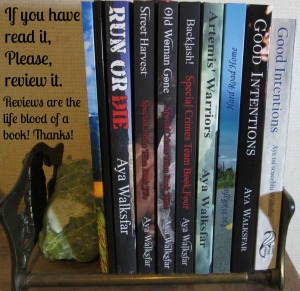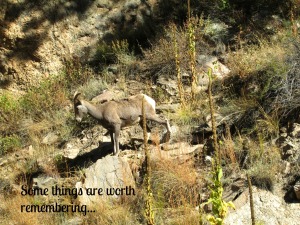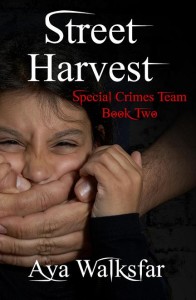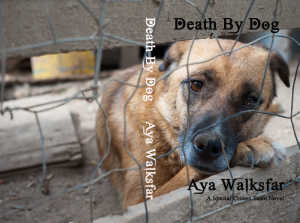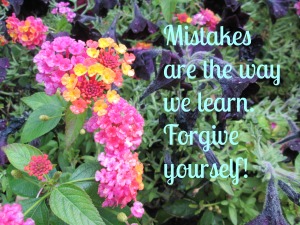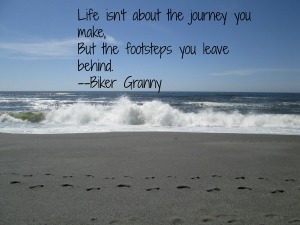Death Comes E-Calling by Leslie O’Kane (Cozy Mystery)
An e-card designer and mom with two children returns to live in her hometown while her husband works overseas for a year. She receives a mysterious and urgent letter from one of her old teachers asking her to visit. Before she can visit, the elderly woman dies. Was she murdered?
Some nice twists occur that involve the designer’s previous classmates. Returning to your childhood home and reconnecting isn’t always fun.
For a cozy easy bedtime read, I’d give it a 3.0.
Seven Daughters by Jessica Lourey (Paranormal)
A bit slow starting. Deals with long standing grudges between two families in a small town. There is an underlying thread of witchery that makes the story intriguing.
For a witch novel easy bedtime read, I’d give it a 3.3.
Lodestone (Witch Hunt) by Wendy Scott (Paranormal)
This witch story hooked me right away and kept me reading. Sabrina is a likeable young witch who faces challenges far beyond her. The author made this character a complex mix of strong/weak; naive/wise. An enjoyable character. If you like witch stories, you will enjoy this one.
A 5.
Circled by Anne McAneny (Murder mystery)
The death of a young girl, Macy, sets into play a string of tragedies that span more than a decade. Protagonist, Chloe, is an interesting, complex character. The story is a tapestry of past and present with unusual characters that kept me reading.
It may be a little confusing right at first, but even then it hooked me. The ending is surprising and well-done.
A definite 5.
Dear Lorna by L.E. Perez (Lesbian love story)
If you enjoy love stories–as opposed to everyone jumps right into bed/romance/sex stories–you will enjoy this one regardless of your gender preference. A surprising book with a bit of a convoluted beginning, but well worth the effort to continue as it soon becomes clear why the author chose this particular writing style: it brings the story alive.
No sex, no graphic violence, but a feeling of how love can grow, be misunderstood, get all tangled up in our fears, and heal in spite of everything.
I strongly recommend this book. A definite 5.
The Trouble with Dying by Maggie LePage (Paranormal)
Faith is dead, but will she stay dead? With help from her Gran’s ghost, Faith must navigate the world that lies in between life and death. The story is told from a coma/potential ghost perspective which makes it a bit different than most stories like this. A love story with a twist.
A nice 4.
Rating of the books from most to least enjoyed:
1. Dear Lorna
2. Circled
3. Lodestone
4. The Trouble with Dying
5. Seven Daughters
6. Death Comes E-Calling
I don’t rate books below a 3 star. If the book, in my opinion is less than a 3 star read, I avoid rating for several reasons: (Most of the time, I avoid reading it, too!)
a. It may simply be a matter of taste. If I had to rate some books, they would be in the negatives. And, that may not be fair to other readers who might enjoy those books.
b. An author works hard to write a novel. If I truly feel the novel lacks in some areas of craft, I will personally write to that author and detail my issues with her/his book. The author gets a heads-up without getting slammed on Amazon. Unfortunately, there are enough Trolls out there willing to rate books at a one star when they have never even read the book–just bought it so they could be “verified” purchasers then returned it immediately for their money back.
Though life is busy, please take a few minutes after reading a book, hop over to Amazon and drop a review. Reviews do not have to be complex, detailed monsters–just two lines about something you liked in the story. Amazon also makes it a bit easier by having easy-to-click buttons for things like Characters–Flat, Developed, Complex and so forth. After clicking those, add in your two-lines and give it a star rating and you’re done!
The reasons I specifically mention Amazon:
a. Many advertisers only count reviews posted on Amazon. These advertisers won’t look at a book unless it has a minimum of ten reviews–usually they want more than that–with a total of 4.5 star rating. Without access to advertisers, Indie Authors are hard put to get their books noticed by the reading public.
b. When a book gains 50 reviews on Amazon, the book will begin showing up in several of Amazon’s feeds. These feeds get the book in front of the reading public.
